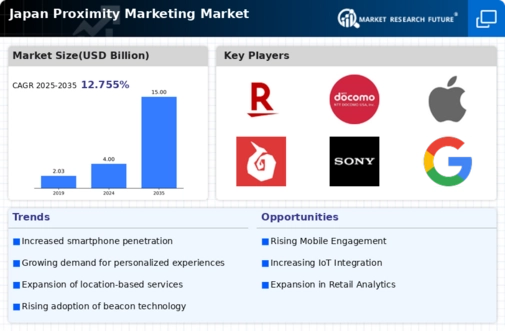Rising Smartphone Penetration
The increasing penetration of smartphones in Japan is a pivotal driver for the proximity marketing market. As of 2025, approximately 85% of the population owns a smartphone, facilitating seamless access to location-based services. This widespread adoption enables businesses to engage consumers through targeted promotions and advertisements based on their real-time locations. The convenience of mobile devices allows for immediate interaction, enhancing customer experiences and driving sales. Furthermore, the integration of advanced technologies such as augmented reality and mobile applications into smartphones is likely to amplify the effectiveness of proximity marketing strategies. Consequently, businesses are expected to invest more in proximity marketing solutions to leverage this growing smartphone user base, thereby propelling the market forward.
Expansion of Retail and E-commerce Sectors
The rapid expansion of both retail and e-commerce sectors in Japan significantly influences the proximity marketing market. In 2025, the retail market is projected to reach approximately $1 trillion, with e-commerce sales contributing a substantial portion. Retailers are increasingly adopting proximity marketing techniques to enhance customer engagement and drive foot traffic to physical stores. By utilizing location-based promotions, businesses can attract consumers who are nearby, thereby increasing the likelihood of impulse purchases. Additionally, the integration of proximity marketing with online shopping platforms allows for a cohesive omnichannel experience, further encouraging consumer loyalty. As competition intensifies, retailers are likely to invest in innovative proximity marketing solutions to differentiate themselves and capture a larger market share.
Technological Advancements in Marketing Tools
Technological advancements play a crucial role in shaping the proximity marketing market. The introduction of sophisticated marketing tools, such as advanced analytics and artificial intelligence, enables businesses to gather and analyze consumer data more effectively. In Japan, companies are increasingly leveraging these technologies to create personalized marketing campaigns that resonate with target audiences. For instance, the use of machine learning algorithms can enhance the accuracy of location-based targeting, ensuring that promotions reach the right consumers at the right time. As these technologies continue to evolve, they are expected to drive innovation within the proximity marketing market, allowing businesses to optimize their strategies and improve return on investment.
Regulatory Environment and Compliance Standards
The regulatory environment and compliance standards in Japan are critical factors influencing the proximity marketing market. As data privacy concerns continue to rise, businesses must navigate complex regulations to ensure compliance while implementing proximity marketing strategies. The Personal Information Protection Act (PIPA) mandates strict guidelines on the collection and use of consumer data, compelling companies to adopt transparent practices. This regulatory landscape may pose challenges for businesses, yet it also presents opportunities for those that prioritize consumer trust and data security. By adhering to compliance standards, companies can enhance their brand reputation and foster customer loyalty, which is likely to drive growth in the proximity marketing market.
Growing Consumer Preference for Personalized Experiences
The growing consumer preference for personalized experiences is a significant driver of the proximity marketing market. In Japan, consumers are increasingly seeking tailored interactions that cater to their individual preferences and needs. This trend is evident in the rising demand for personalized promotions and recommendations based on location data. Businesses that adopt proximity marketing strategies can effectively meet these consumer expectations by delivering relevant offers in real-time. As a result, companies are likely to invest in technologies that facilitate personalized marketing, such as geofencing and beacon technology. This shift towards personalization not only enhances customer satisfaction but also fosters brand loyalty, ultimately contributing to the growth of the proximity marketing market.

















Leave a Comment